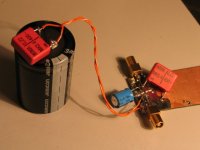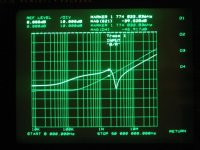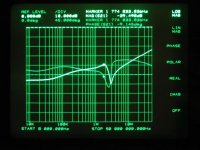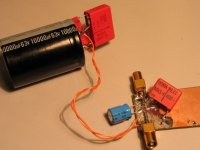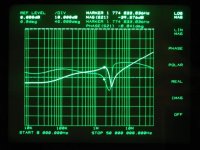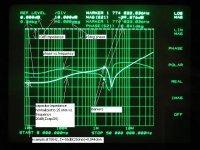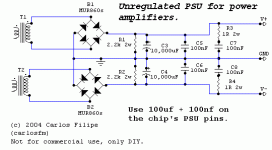Konnichiwa,
You present an interesting view, but, to quote sporting life from Porgy & Bess, "It ain't neccesarily so!".
Let us take two possible cases of a blind test for an item where both Objectivists and Subjectivists have defined preconceptions of what holds true.
Let us assume the following cases:
1) The Objectivist assumes no difference exists with a strong conviction. A difference exists that is audible, however the self deception is fully active as the objectivist is incorrectly convinced no difference is audible. Result = Returned score non-significant.
2) The Objectivist assumes no difference exists with a strong conviction. No difference exists that is audible, self deception is not active as the objectivist is correctly convinced no difference is audible. Result = Returned score non-significant.
3) The Subjectivist assumes a difference exists with a strong conviction. A difference exists that is audible, however the self deception is fully active as the subjectivist is incorrectly convinced a difference is audible even if the two items are in fact the same. Result = Returned score non-significant.
4) The Subjectivist assumes a difference exists with a strong conviction. No difference exists that is audible,, the self deception is fully active as the subjectivist is incorrectly convinced a difference is audible even if the two items are in fact the same. Result = Returned score non-significant.
What have we learned?
People will hear what they want to hear. The person convinced differences exists will hear them regardless of their actual presence in a blind test. The person convinced no differences exists will hear no differences regardless of their actual presence in a blind test. The test outcome is invariably a "Null" result.
This can be easily prooven by actually "blind testing" the blind test, meaning the test subjects are told they will audition a highly controversial change, about which they have strong and definite views, what is instead auditioned is a change that is in fact considered audible with reasonable certainty, but is nevertheless fairly small.
A reverse test may be made using no change and suggesting that in fact a difference is being auditioned that is reliably audible, equally some bias can be removed by auditioning the questionable change with the pretext of in fact auditioning a reliably audible one.
All of that will of course (after you revealed what you did) leave you with a lot of irate people.
I wish people would stop waving around with "DB Test Results prove this or that" (they don't prove the absence of anything anyway) and would first stop to consider what is actually involved.
Past that, well everyone should make their own tests, any which way they like and follow their own results and advise, without neccesarily expecting that everyone else will take their results (no matter what test they result from) as the absolute gospel.
Yet it is also advisable to others to simply let a statement like "I did such and such and got the result such and such" stand in their own merit, if neccesary request qualification of the experimental procedure, personal biasees etc., but cut out the constant blanket rubbishing of such experimentation. If you want to discuss something, do the same experiment and report your results, preferably stating your biases and experimental methode and allow the reader to draw her or his own conclusions.
So, less discussions please as to why X cannot work (or why it may), less discussions dogmatically claiming that ABX tests are the only way and actually are a reliable methode to get results IN THE SPECIFIC ENVOIRONMENT UNDER DISCUSSION and more actual experimental work. If such work is reported in sufficient detail it is highly useful, certainly a lot more so than the stoical bovine repeating of "the earth is the centre of the universe and it is flat, anyone disputing these self evident truth is clearly deluded"....
Sayonara
janneman said:In a well prepared blind test, the self-deception isn't active; after all, there are no clues to trigger a perception one way or another. The listener is convicted to try to make sense of what he/she hears only.
You present an interesting view, but, to quote sporting life from Porgy & Bess, "It ain't neccesarily so!".
Let us take two possible cases of a blind test for an item where both Objectivists and Subjectivists have defined preconceptions of what holds true.
Let us assume the following cases:
1) The Objectivist assumes no difference exists with a strong conviction. A difference exists that is audible, however the self deception is fully active as the objectivist is incorrectly convinced no difference is audible. Result = Returned score non-significant.
2) The Objectivist assumes no difference exists with a strong conviction. No difference exists that is audible, self deception is not active as the objectivist is correctly convinced no difference is audible. Result = Returned score non-significant.
3) The Subjectivist assumes a difference exists with a strong conviction. A difference exists that is audible, however the self deception is fully active as the subjectivist is incorrectly convinced a difference is audible even if the two items are in fact the same. Result = Returned score non-significant.
4) The Subjectivist assumes a difference exists with a strong conviction. No difference exists that is audible,, the self deception is fully active as the subjectivist is incorrectly convinced a difference is audible even if the two items are in fact the same. Result = Returned score non-significant.
What have we learned?
People will hear what they want to hear. The person convinced differences exists will hear them regardless of their actual presence in a blind test. The person convinced no differences exists will hear no differences regardless of their actual presence in a blind test. The test outcome is invariably a "Null" result.
This can be easily prooven by actually "blind testing" the blind test, meaning the test subjects are told they will audition a highly controversial change, about which they have strong and definite views, what is instead auditioned is a change that is in fact considered audible with reasonable certainty, but is nevertheless fairly small.
A reverse test may be made using no change and suggesting that in fact a difference is being auditioned that is reliably audible, equally some bias can be removed by auditioning the questionable change with the pretext of in fact auditioning a reliably audible one.
All of that will of course (after you revealed what you did) leave you with a lot of irate people.
I wish people would stop waving around with "DB Test Results prove this or that" (they don't prove the absence of anything anyway) and would first stop to consider what is actually involved.
Past that, well everyone should make their own tests, any which way they like and follow their own results and advise, without neccesarily expecting that everyone else will take their results (no matter what test they result from) as the absolute gospel.
Yet it is also advisable to others to simply let a statement like "I did such and such and got the result such and such" stand in their own merit, if neccesary request qualification of the experimental procedure, personal biasees etc., but cut out the constant blanket rubbishing of such experimentation. If you want to discuss something, do the same experiment and report your results, preferably stating your biases and experimental methode and allow the reader to draw her or his own conclusions.
So, less discussions please as to why X cannot work (or why it may), less discussions dogmatically claiming that ABX tests are the only way and actually are a reliable methode to get results IN THE SPECIFIC ENVOIRONMENT UNDER DISCUSSION and more actual experimental work. If such work is reported in sufficient detail it is highly useful, certainly a lot more so than the stoical bovine repeating of "the earth is the centre of the universe and it is flat, anyone disputing these self evident truth is clearly deluded"....
Sayonara
Thorsten,
Rather than repeating your post and reacting on each and every statement, allow me to summarise the way I see it.
I agree that there are many shortcomings to ANY test method. And I don't want to go on record that ANY blind test gives meaningfull outcomes. But, if I do a well set up blind test between two pieces of equipment, and the outcome statistically significant correctly identifies the different pieces of equipment, that is proof that there is an audible difference.
As you say, if that is not the case, it does NOT prove there is NO audible difference. I think this state of affairs is recognised by most if not all blind test proponents. I never seen a statement: "hey, there was a 50-50 score, so this PROVES there is no audible difference". This would obviously be a wrong statement.
Often, what is stated is something like " just show me ONE statistically significant test result for audibility, and I acceept that there IS an audible difference". That, I think, is a reasonable and logical position.
On the other hand, if you do sighted tests, what do you have in terms of statistically significance? How do you find out that if there is a reported audible difference, that it is not caused by differences in size, color, prize, impression etc? You can't. So, even if I recognise that blind tests are not the perfect tool, they are infinitely more effective, efficient and trustworthy than a sighted test. If you really, really want to know about audible differences, I know of no tool that comes even close to a blind test.
Jan Didden
Rather than repeating your post and reacting on each and every statement, allow me to summarise the way I see it.
I agree that there are many shortcomings to ANY test method. And I don't want to go on record that ANY blind test gives meaningfull outcomes. But, if I do a well set up blind test between two pieces of equipment, and the outcome statistically significant correctly identifies the different pieces of equipment, that is proof that there is an audible difference.
As you say, if that is not the case, it does NOT prove there is NO audible difference. I think this state of affairs is recognised by most if not all blind test proponents. I never seen a statement: "hey, there was a 50-50 score, so this PROVES there is no audible difference". This would obviously be a wrong statement.
Often, what is stated is something like " just show me ONE statistically significant test result for audibility, and I acceept that there IS an audible difference". That, I think, is a reasonable and logical position.
On the other hand, if you do sighted tests, what do you have in terms of statistically significance? How do you find out that if there is a reported audible difference, that it is not caused by differences in size, color, prize, impression etc? You can't. So, even if I recognise that blind tests are not the perfect tool, they are infinitely more effective, efficient and trustworthy than a sighted test. If you really, really want to know about audible differences, I know of no tool that comes even close to a blind test.
Jan Didden
Excuse me, if I will be a bit "off topic" with respect to your latest discussion, but I would like to respond to some of the questions
posted before.
Jan asked me to try to test the setup, when the "snubber" is on the
large cap. I had a gut feeling about the possible outcome, but tried it anyway.
Also, I somehow felt "guilty" for neglecting Carlos's original scheme, and given the fact that Jan's question was also about it, now I tried to replicate it faithfully.
So this would be the setup a' la Carlos, first without snubber, am I right?
posted before.
Jan asked me to try to test the setup, when the "snubber" is on the
large cap. I had a gut feeling about the possible outcome, but tried it anyway.
Also, I somehow felt "guilty" for neglecting Carlos's original scheme, and given the fact that Jan's question was also about it, now I tried to replicate it faithfully.
So this would be the setup a' la Carlos, first without snubber, am I right?
Attachments
Well Carlos,
While I didn't like regulation on a GC, yesterday I tried your version of snubberized PS (except for 100n bypass on a big cap) and I have to admit that I really like it. It might be even better than running the amp from batteries.
I used BG N 100/50 directly at the chip and 10,000/63 Jensen 4-pole caps at the bridges.
While I didn't like regulation on a GC, yesterday I tried your version of snubberized PS (except for 100n bypass on a big cap) and I have to admit that I really like it. It might be even better than running the amp from batteries.
I used BG N 100/50 directly at the chip and 10,000/63 Jensen 4-pole caps at the bridges.
An externally hosted image should be here but it was not working when we last tested it.
Joseph K said:And here is the response:
Indeed, here is my response
Hello Joseph,
The images look very nice, but could you (or somebody else) explain how to read/interpret them?
Now, if You can not see a difference, it's the same as for me!
My opinion is, that the local 100 uF bypass capacitor swamps out the not so great impedance deviations on the other side, so the change, what the "snubber" causes LOCALLY on the big cap, is not visible from the chip's power supply pin. More or less this was the reason, why I said last time, that in my opinion, these measurements does not make clear the real nature of the "snubber effect". For me, this says, that the snubber, applied there, not LOCALLY, has some other effect, maybe really snubbing the transformer - diodes capacity tank circuit, but it's only a guess..
Thank's for your attention! george
My opinion is, that the local 100 uF bypass capacitor swamps out the not so great impedance deviations on the other side, so the change, what the "snubber" causes LOCALLY on the big cap, is not visible from the chip's power supply pin. More or less this was the reason, why I said last time, that in my opinion, these measurements does not make clear the real nature of the "snubber effect". For me, this says, that the snubber, applied there, not LOCALLY, has some other effect, maybe really snubbing the transformer - diodes capacity tank circuit, but it's only a guess..
Thank's for your attention! george
Joseph K said:Squadra, the measurement setup I have explained in post 153 of this thread! (At least I hope so)
Sorry, must have missed that one.
Still it doesn't make much sense to me, maybe reading it again a few times will help
Anyway, thanks
janneman said:Or do you propose to skip the first cap? That wouldn't work, you need *some* initial cap as reservoir otherwise your rectified voltage will be much, much smaller than expected.
Yes, I propose to skip the first cap. Hence the name choke input filter. It would certainly work and would reduce the charging current to the caps, but would require larger transformers. Is this such a problem? It's done all the time in valve amps.
squadra said:.... but could you (or somebody else) explain how to read/interpret them....
.
Attachments
Peter Daniel said:Well Carlos,
While I didn't like regulation on a GC, yesterday I tried your version of snubberized PS (except for 100n bypass on a big cap) and I have to admit that I really like it. It might be even better than running the amp from batteries.
I used BG N 100/50 directly at the chip and 10,000/63 Jensen 4-pole caps at the bridges.
I knew you would like it.
Thanks for reporting.
Joseph K said:Now I have put the snubber, where it belongs.. (a' la Carlos)
Am I right?
No...
Please try it with my values!

Thanks.
Attachments
Squadra, these graphs show you the behaviour of a given bypass element as a function of frequency. Be it a capacitor, inductor or a more complex network. What you see on the analyser screen is this function, in different formats: magnitude or phase graphs.
It means, that the analyser puts out a reference signal, (sweeps it from, lets say 5 kHz to 200 ooo kHz) and looks at the signal, which arrives at it's receiver port. The magnitude graph shows you, in dB, the difference between the reference signal level, and the signal level at the receiver port. We are looking for attenuation, and as you can see, I put, as a sample, 1 ohm on the test jig for calibration, and indeed, the magnitude of that calib. graph shows how that resistance attenuates the reference signal by 28 dB. It is also visible there, that it is valid only for more "human", low frequencies. at about 100 MHz even a resistor, or at least as it is connected in that setup, starts to behave more like an inductance.
The phase graph present on the second trace on these pics shows the phase difference between the reference signal, as put out (or better, driven by the analyser output port), and the received signal.
It is 45 degree/div in these pictures, as it is written on the screen.
Hope this helps! george
It means, that the analyser puts out a reference signal, (sweeps it from, lets say 5 kHz to 200 ooo kHz) and looks at the signal, which arrives at it's receiver port. The magnitude graph shows you, in dB, the difference between the reference signal level, and the signal level at the receiver port. We are looking for attenuation, and as you can see, I put, as a sample, 1 ohm on the test jig for calibration, and indeed, the magnitude of that calib. graph shows how that resistance attenuates the reference signal by 28 dB. It is also visible there, that it is valid only for more "human", low frequencies. at about 100 MHz even a resistor, or at least as it is connected in that setup, starts to behave more like an inductance.
The phase graph present on the second trace on these pics shows the phase difference between the reference signal, as put out (or better, driven by the analyser output port), and the received signal.
It is 45 degree/div in these pictures, as it is written on the screen.
Hope this helps! george
janneman said:No, I think what you described is what I would expect.
No, I don't think you do. Here is an example:
Fred has built fancy interconnects. Fred loves his fancy interconnects. He spent lots of money and effort on them. After comparing them to other interconnects, both commercial and DIY, he believes they are the best he has ever heard.
John is attending an audio gathering at Fred's home. Fred has just met John. Fred doesn't know anything about John. John has brought some interconnects. Fred doesn't know anything about John's interconnects other than they look cheap and easy to make.
Being the nice fellow that Fred is, he offers to use John's interconnects in his system for the second half of the listening session. Fred hopes that the change will not cause too much embarrassment for John as Fred is certain of his own interconnect's superiority.
Much to Fred's deep disappointment and against his prior expectation, he finds that John's cheap interconnects sound better than his expensive ones.
How could this ever happen? Shouldn't self-deception never allow it? While I wouldn't say this sort of thing is a normal occurrance, it happens often enough.
In sighted tests I've preferred a number of cheap and easy to get components to ones I've gone to considerable expense and effort to acquire. It doesn't seem like this should be possible.
- Status
- This old topic is closed. If you want to reopen this topic, contact a moderator using the "Report Post" button.
- Home
- Amplifiers
- Chip Amps
- Carlos' snubberized Gainclone Power supply


